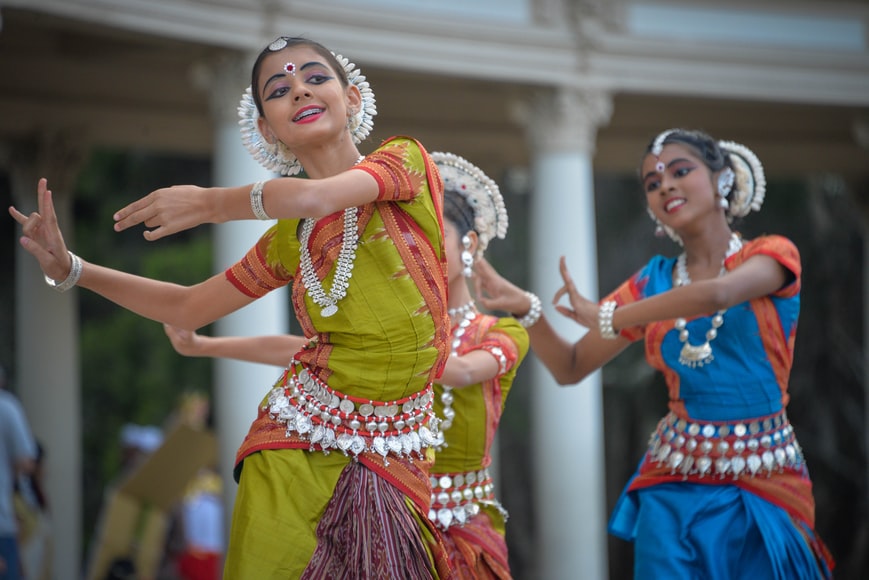India is a land of rich culture and heritage. Right from the days of yore rituals and festivals are a part of our tradition. It is, therefore, no surprise that we add a little colour to our practices through Indian classical dance and music!
Get ready to explore some of the many classical dances India has, to present to you!
A few pointers to register beforehand:
- Firstly, one must keep in mind that even though certain themes and concepts might be similar across the dance forms, the dance form itself is unique due to geographic, linguistic and other factors.
- Secondly, another detail to be aware of is that of ‘bani’ or ‘style’. This is a term used to describe the dance technique and style specific to a guru or school. Implying a dance form can have several ‘styles’ or ‘banis’.
- Lastly, Indian classical dance forms delve into the depths of Hinduism and Indian Mythology.
Let’s get dancing!
Bharatanatyam, an Indian classical dance
Origin: Tamizh Nadu
Bharatnatyam is one of the most intricate, systematized, sought-after and widely practiced classical dance forms of India. As the name suggests it refers to Bharata Muni’s Natyam i.e. Sage Bharata’s dance. The predominant and exclusive stance is ‘Araimandi’ ( Tamizh, Arai – half, Mandi – sitting). The traditional repertoire or ‘margam’ fashioned by the Tanjore Quartet (the 4 well-known composers for dance) gives us a holistic insight into the various aspects of Bharatanatyam – Nritta (pure dance), Nritya (pure dance with expressions) and Natya (solely expressions). A popular and powerful yet graceful dance form – Bharatanatyam is loved globally.
Bharatanatyam has become a global phenomenon, and it is no wonder that people from all around the world wish to learn Bharatanatyam. Many learn virtually from Indian gurus as it is important to dance to the rhythm with precise mudras and coordination. Learning online allows you to choose your own teacher and learn at your own pace. If you live close to a Bharatnatyam dance class, you can always sign up and learn in a more interactive setting.
Kathak
Origin: Uttar Pradesh and Rajasthan
The name is extracted from the words ‘katha’ meaning story and ‘kathakar’ meaning storyteller. This dance form revolves predominantly around the Hindu God, Sri Krishna. The ‘tatkkar’ (footwork), ‘chaal’ (stylized way of walking), ‘ladi’ (sequence of rhythmic patterns involving mainly footwork) and the famous ‘chakkars’ (spin) are the principal elements of Kathak. Like Bharatanatyam, Kathak too has a repertoire. The term ‘gharana’ is used in place of ‘bani’. Unexpectedly, Kathak has a strong Muslim influence in its art form (as a result of the Mughal rule) aside from Hinduism. The brisk footwork, ’bhava’ and dizzying ‘chakkars’ sure do keep us on the edge of our seats!
Over time, Kathak has evolved into classical, contemporary and sufi. Fundamentally, a ‘kathakar’ requires mastery over precise moves, flexibility, both brisk and slow-paced performances, and breathing techniques. Storytelling through dance may not be easy but if a teacher guides you to learn Kathak dance then you can quickly acquire the skills of the art form. All you need to do is follow your dreams and you can transform from a novice to an expert Kathak dancer.
Odissi
Origin: Odisha
If temples and sculptures are your cup of tea, well this is the dance for you. The main postures seen are ‘dvibhanga’ ( 2 symmetrical bends in the body), ‘tribhanga’ (3 symmetrical bends in the body), and ‘chauk’ (meaning chair-like pose, which has a slight resemblance to Bharatanatyam’s ‘Araimandi’). This dance form’s repertoire is synonymous with the various stages in life starting from birth and culminating in salvation or ‘Moksha'( freedom from the cycle of birth and death). Odissi illustrates Vaishnavism largely. It truly is a treat to watch sculpture-like poses come alive in front of our eyes.
Sattriya
Origin: Assam (pronounced as Ahom)
Similarly, yet another dance form revolving around Vaishnavism is Sattriya. Lord Krishna is once again the deity invoked through this dance. Interestingly, the performance doesn’t customarily take place before an idol. The performers perform in front of the ‘Bhagavata Purana’ (a Sanskrit Text) placed in the eastern direction. The effortlessly executed movements and prances across the dias arrest the audience’s attention.
With all that’s said is just the tip of the iceberg! So, if you are looking for spirituality, fun, satisfaction and fitness, what better than learning an Indian classical dance Form?
